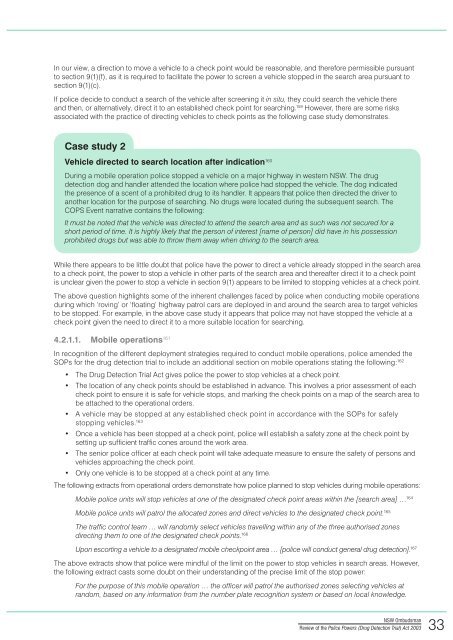Review of the Police Powers (Drug Detection Trial) Act 2003 - NSW ...
Review of the Police Powers (Drug Detection Trial) Act 2003 - NSW ...
Review of the Police Powers (Drug Detection Trial) Act 2003 - NSW ...
Create successful ePaper yourself
Turn your PDF publications into a flip-book with our unique Google optimized e-Paper software.
In our view, a direction to move a vehicle to a check point would be reasonable, and <strong>the</strong>refore permissible pursuant<br />
to section 9(1)(f), as it is required to facilitate <strong>the</strong> power to screen a vehicle stopped in <strong>the</strong> search area pursuant to<br />
section 9(1)(c).<br />
If police decide to conduct a search <strong>of</strong> <strong>the</strong> vehicle after screening it in situ, <strong>the</strong>y could search <strong>the</strong> vehicle <strong>the</strong>re<br />
and <strong>the</strong>n, or alternatively, direct it to an established check point for searching. 159 However, <strong>the</strong>re are some risks<br />
associated with <strong>the</strong> practice <strong>of</strong> directing vehicles to check points as <strong>the</strong> following case study demonstrates.<br />
Case study 2<br />
Vehicle directed to search location after indication 160<br />
During a mobile operation police stopped a vehicle on a major highway in western <strong>NSW</strong>. The drug<br />
detection dog and handler attended <strong>the</strong> location where police had stopped <strong>the</strong> vehicle. The dog indicated<br />
<strong>the</strong> presence <strong>of</strong> a scent <strong>of</strong> a prohibited drug to its handler. It appears that police <strong>the</strong>n directed <strong>the</strong> driver to<br />
ano<strong>the</strong>r location for <strong>the</strong> purpose <strong>of</strong> searching. No drugs were located during <strong>the</strong> subsequent search. The<br />
COPS Event narrative contains <strong>the</strong> following:<br />
It must be noted that <strong>the</strong> vehicle was directed to attend <strong>the</strong> search area and as such was not secured for a<br />
short period <strong>of</strong> time. It is highly likely that <strong>the</strong> person <strong>of</strong> interest [name <strong>of</strong> person] did have in his possession<br />
prohibited drugs but was able to throw <strong>the</strong>m away when driving to <strong>the</strong> search area.<br />
While <strong>the</strong>re appears to be little doubt that police have <strong>the</strong> power to direct a vehicle already stopped in <strong>the</strong> search area<br />
to a check point, <strong>the</strong> power to stop a vehicle in o<strong>the</strong>r parts <strong>of</strong> <strong>the</strong> search area and <strong>the</strong>reafter direct it to a check point<br />
is unclear given <strong>the</strong> power to stop a vehicle in section 9(1) appears to be limited to stopping vehicles at a check point.<br />
The above question highlights some <strong>of</strong> <strong>the</strong> inherent challenges faced by police when conducting mobile operations<br />
during which ‘roving’ or ‘floating’ highway patrol cars are deployed in and around <strong>the</strong> search area to target vehicles<br />
to be stopped. For example, in <strong>the</strong> above case study it appears that police may not have stopped <strong>the</strong> vehicle at a<br />
check point given <strong>the</strong> need to direct it to a more suitable location for searching.<br />
4.2.1.1. Mobile operations 161<br />
In recognition <strong>of</strong> <strong>the</strong> different deployment strategies required to conduct mobile operations, police amended <strong>the</strong><br />
SOPs for <strong>the</strong> drug detection trial to include an additional section on mobile operations stating <strong>the</strong> following: 162<br />
• The <strong>Drug</strong> <strong>Detection</strong> <strong>Trial</strong> <strong>Act</strong> gives police <strong>the</strong> power to stop vehicles at a check point.<br />
• The location <strong>of</strong> any check points should be established in advance. This involves a prior assessment <strong>of</strong> each<br />
check point to ensure it is safe for vehicle stops, and marking <strong>the</strong> check points on a map <strong>of</strong> <strong>the</strong> search area to<br />
be attached to <strong>the</strong> operational orders.<br />
• A vehicle may be stopped at any established check point in accordance with <strong>the</strong> SOPs for safely<br />
stopping vehicles. 163<br />
• Once a vehicle has been stopped at a check point, police will establish a safety zone at <strong>the</strong> check point by<br />
setting up sufficient traffic cones around <strong>the</strong> work area.<br />
• The senior police <strong>of</strong>ficer at each check point will take adequate measure to ensure <strong>the</strong> safety <strong>of</strong> persons and<br />
vehicles approaching <strong>the</strong> check point.<br />
• Only one vehicle is to be stopped at a check point at any time.<br />
The following extracts from operational orders demonstrate how police planned to stop vehicles during mobile operations:<br />
Mobile police units will stop vehicles at one <strong>of</strong> <strong>the</strong> designated check point areas within <strong>the</strong> [search area] … 164<br />
Mobile police units will patrol <strong>the</strong> allocated zones and direct vehicles to <strong>the</strong> designated check point. 165<br />
The traffic control team … will randomly select vehicles travelling within any <strong>of</strong> <strong>the</strong> three authorised zones<br />
directing <strong>the</strong>m to one <strong>of</strong> <strong>the</strong> designated check points. 166<br />
Upon escorting a vehicle to a designated mobile checkpoint area … [police will conduct general drug detection]. 167<br />
The above extracts show that police were mindful <strong>of</strong> <strong>the</strong> limit on <strong>the</strong> power to stop vehicles in search areas. However,<br />
<strong>the</strong> following extract casts some doubt on <strong>the</strong>ir understanding <strong>of</strong> <strong>the</strong> precise limit <strong>of</strong> <strong>the</strong> stop power:<br />
For <strong>the</strong> purpose <strong>of</strong> this mobile operation … <strong>the</strong> <strong>of</strong>ficer will patrol <strong>the</strong> authorised zones selecting vehicles at<br />
random, based on any information from <strong>the</strong> number plate recognition system or based on local knowledge.<br />
<strong>NSW</strong> Ombudsman<br />
<strong>Review</strong> <strong>of</strong> <strong>the</strong> <strong>Police</strong> <strong>Powers</strong> (<strong>Drug</strong> <strong>Detection</strong> <strong>Trial</strong>) <strong>Act</strong> <strong>2003</strong><br />
33

















